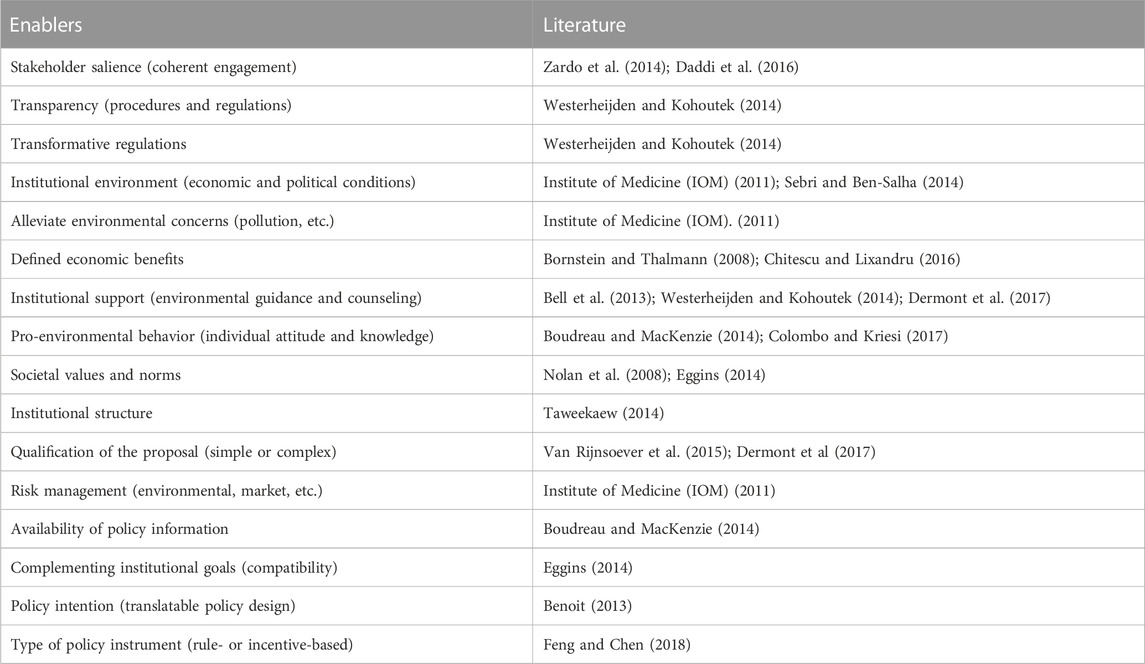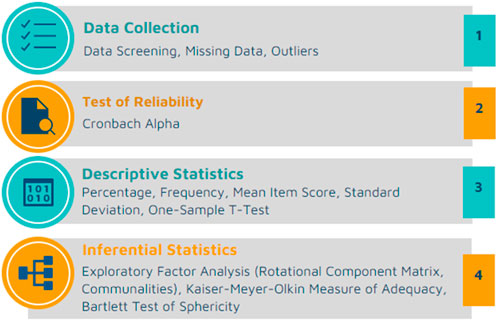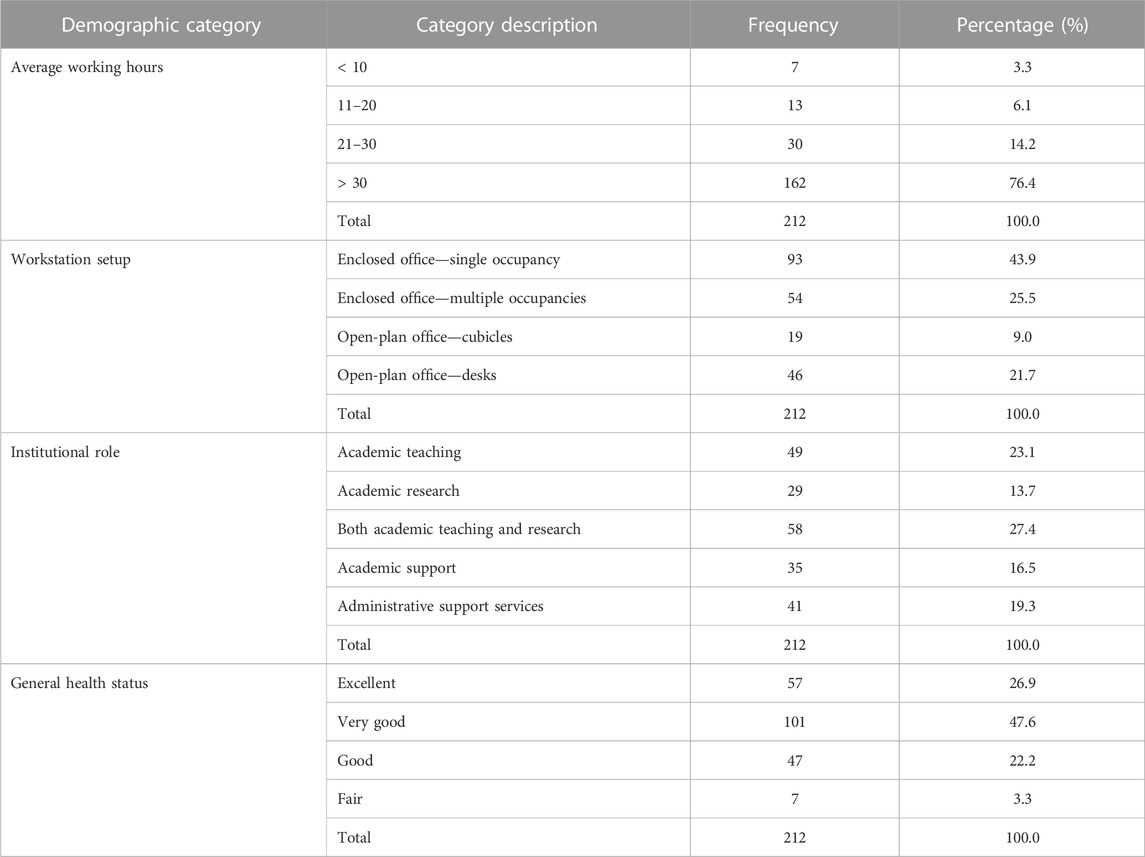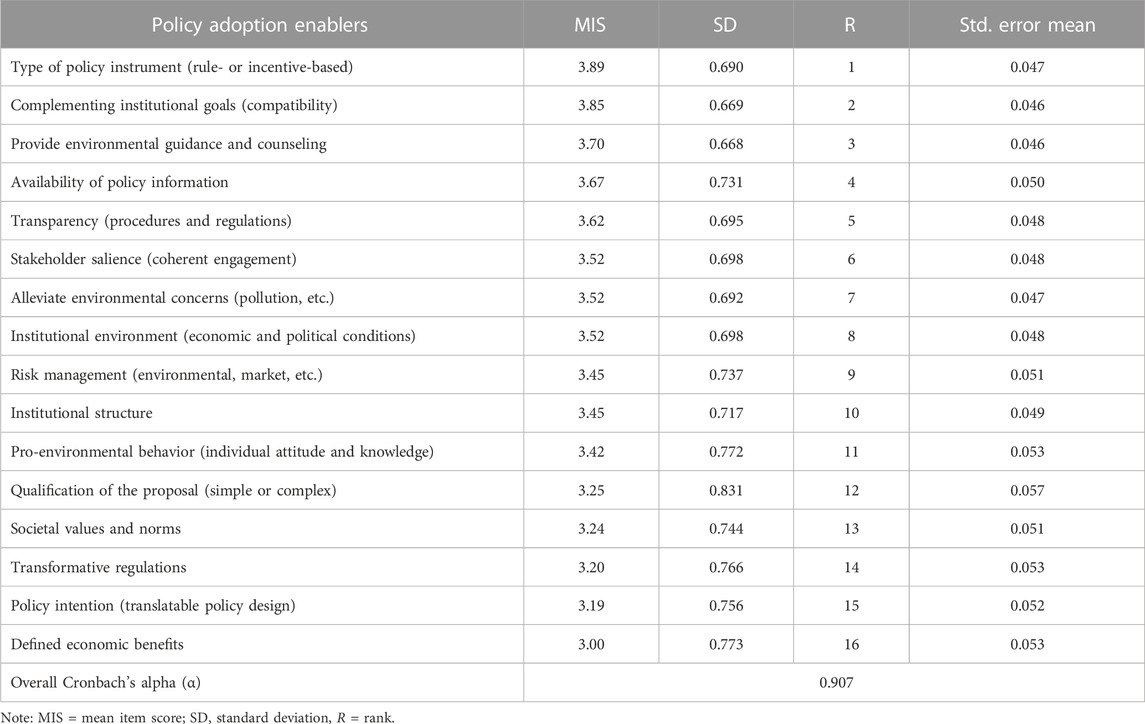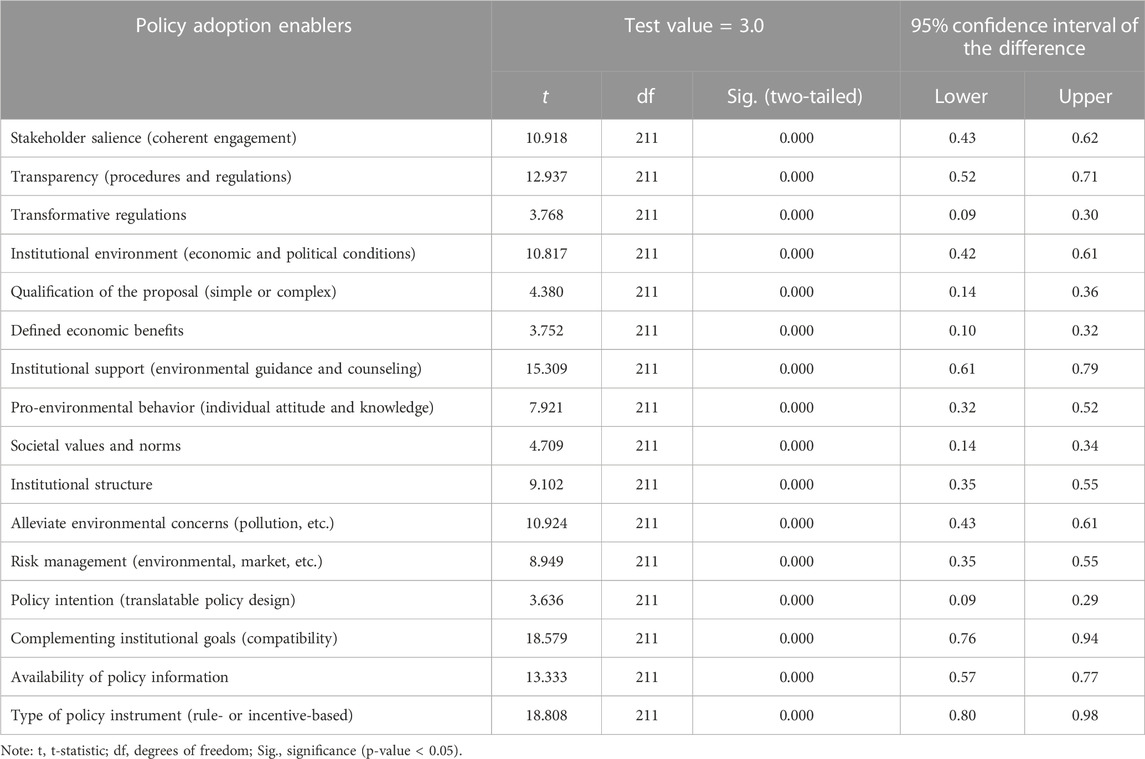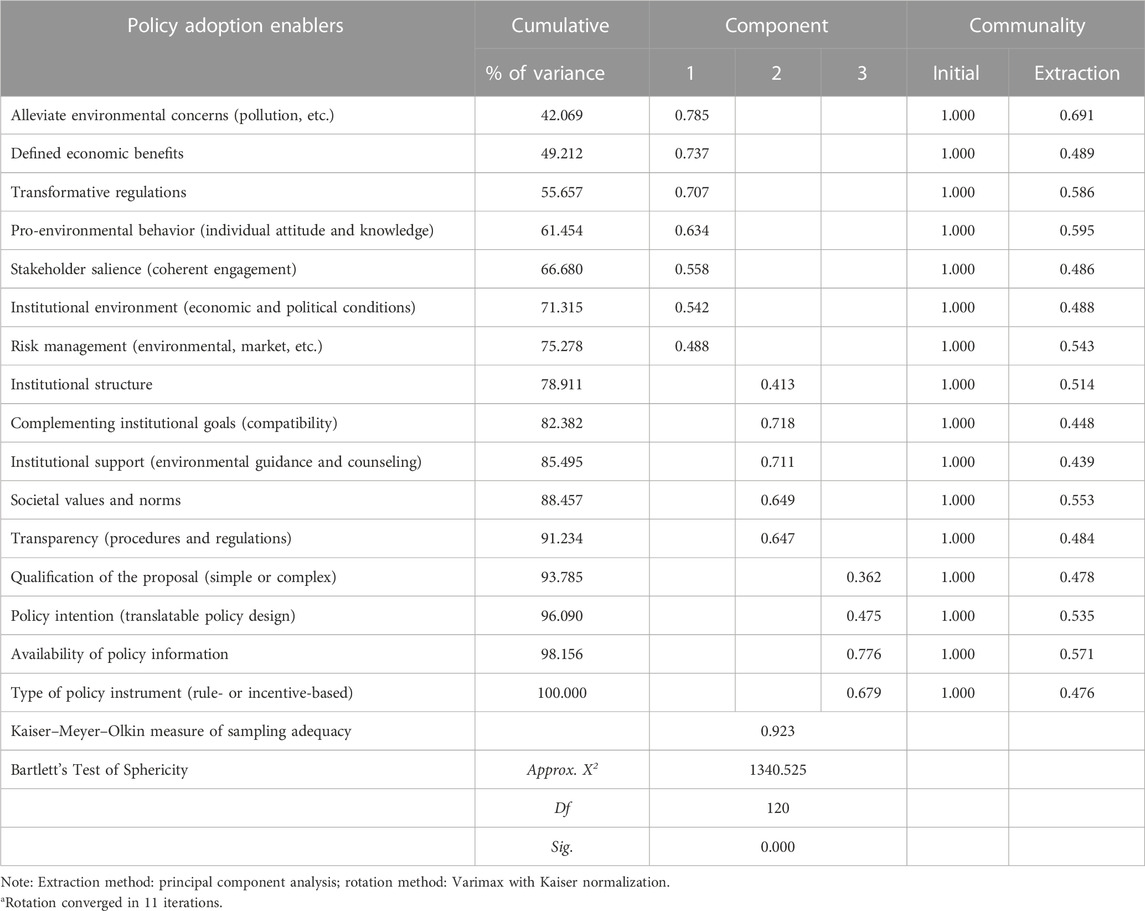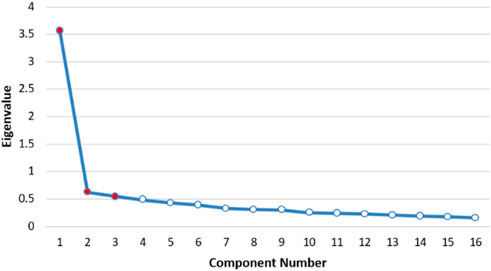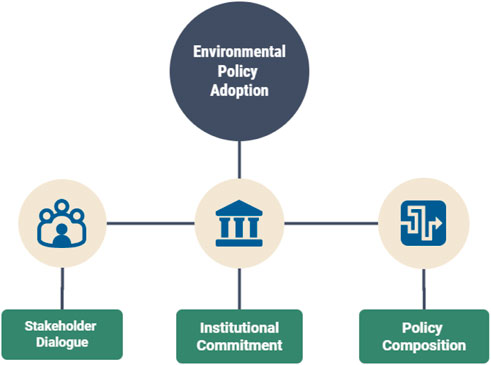- CIDB Centre of Excellence and Sustainable Human Settlement and Construction Research Centre, Faculty of Engineering and the Built Environment, University of Johannesburg, Johannesburg, South Africa
Purpose: This study seeks to investigate the extent to which the indoor air quality (IAQ) management of higher educational institutions (HEIs) in South Africa could be improved through the appropriate implementation of environmental policy adoption enablers. Multiple challenges have been documented to the improvement of IAQ standards in HEIs. However, an alternative to the management of IAQ is possible through environmental behavioral change.
Research Methodology: A philosophical stance of post-positivism influences the adoption of a quantitative research approach for this study. Primary data on the views shared by various academic and administrative staff employed by HEIs across South Africa were collected using a closed-ended questionnaire survey. A literature review uncovered 16 influential environmental policy adoption enablers that could further the objective of the study. A four-phase data analytical approach was adopted to interpret the empirical data through screening and reliability assessment, together with descriptive and inferential statistical evaluations, to ascertain the influence held by the surveyed policy adoption enablers on improving the management of IAQ in HEIs.
Results: The inferential statistical evaluation using exploratory factor analysis revealed three crucial environmental policy adoption metrical approaches (stakeholder dialogue, institutional commitment, and policy composition) to the management of IAQ in HEIs.
Discussion: From a practical perspective, the administrative council of HEIs could consider the identified policy adoption enablers as a catalyst for pro-environmental behavior and the management of IAQ in all respective institutions. Theoretically, this study contributes to the body of knowledge by providing factors associated with environmental policy adoptions for IAQ management and laying the groundwork for future research in environmental behavior, this has been lacking in previous IAQ studies and current environmental management discourse. As an instrumental enabler, the identified policy adoption approaches could inform any existing or new institutional policy adoption initiative aimed at improving current individuals’ perception of workplace comfort, satisfaction, and performance directly associated with their indoor environmental conditions.
1 Introduction
Higher educational institutions (HEIs) are key to developing any country’s social, political, and economic systems. Alemu (2019) described HEIs as a collective of institutions administering teaching, learning, and content creation in a conducive environment at the tertiary level. Due to their important role, the failure of HEIs to meet their objective function—education in its entirety—would delay any transformative goal a country might have for its development (economic growth, social dynamics, and policies). Since most people spend most of their time indoors, challenges associated with health issues experienced by occupants have become a growing concern since worsening climate change influences human well-being and performance in various ways (Al Horr et al., 2016; Mohamed et al., 2021). Furthermore, the continuous decay of environmental conditions has been fueled by industrialization’s quest to develop “archaic” environments. However, the opposite is true, as the very environmental development activities now threaten their beneficiaries (Alam and Paramati, 2015; Shahbaz et al., 2019). A conducive facility for teaching and learning is necessary for the pursuit of occupant well-being, optimal productivity, and quality education; this can be achieved through adequate indoor environmental quality (IEQ) management of HEIs (Sadick, 2018).
The first initiative in addressing IEQ inadequacies is to understand the elements that affect it and its effect on the occupants of indoor spaces. The phenomenon of IEQ encompasses four main environmental conditions: air quality (constituents, odors, and pollutants), thermal environment (temperature and humidity), acoustics (sound), and luminance (light) (Sakhare and Ralegaonkar, 2014; Godish, 2016). The current study focused mainly on indoor air quality (IAQ) since multiple studies have been conducted on empirical IEQ assessment modeling and indexing, together with the overall influence of IEQ and its impact on energy performance (Sakhare and Ralegaonkar, 2014; Leccese et al., 2021). To date, there have been limited efforts to create a legislative directive that addresses the well-being of occupants specifically in relation to their IAQ environment. However, environmental regulatory standards and/or legislative policies aimed at alleviating pollution are in place and are used as a form of IAQ guidelines by the European Union (Bluyssen, 2010). It must be noted that, for an ideal indoor environment in any country, guidelines and standards are necessary and should reflect internal (political, economic, and social status) and external (geographical disposition and climate regime) factors.
There is limited information on the overall satisfaction with IAQ management in HEIs, especially in developing countries. Mendell and Heath (2005) emphasized the lack of empirical data on the influence of thermal conditions in academic environments. Although most countries have adopted the benchmarked and accepted international standards or guidelines from ASHRAE (American Society of Heating, Refrigerating, and Air-Conditioning Engineers), the European Commission (EC), the World Health Organization (WHO), and the International Organization for Standardization (ISO) , not all environmental parameters have been adopted by all countries (Bluyssen, 2010; Abdul-Wahab et al., 2015; Mujeebu and Bano, 2022). Thus, it is necessary to review how these policies can be better implemented and adopted in key public indoor spaces such as HEIs. The current study, therefore, seeks to investigate critical enablers that will allow for better IAQ management in HEIs in South Africa through the adoption of environmental policies. Practically, the study contributes to the body of knowledge on IAQ by identifying crucial policy adoption enablers in the quest for a conducive teaching and learning environment. The study begins with a review of the literature and an outline of the research methodology adopted. The data collected are analyzed, followed by conclusions and recommendations drawn from the study’s findings.
2 Literature review
Respiration is the pathway to life, but while we breathe every second, not every breath is clean. WHO (2015) advocates that every human should have access to healthy indoor air within their indoor environments, as the air we breathe affects our health, which in turn influences our quality of life and well-being. The inadequacy of IAQ control can be linked to various factors associated with ambient conditions, indoor and outdoor contaminants, construction materials, and poor building design and maintenance. Similarly, thermal comfort is affected by various mediating variables such as the season, age, gender, ethnicity, geographical climate, and location (Mohamed et al., 2021; Hormigos-Jimenez et al., 2018). Awareness of health and its significance for adequate IAQ is limited in many developing societies, including South Africa (Brits, 2012). Although efforts have been made to establish environmental policies that have human interests at heart, limited development has been seen in creating IAQ legislation specific to South Africa. The first initiative in combating any poor IAQ environment is to introduce an IAQ-specific policy that deals with the underlying elements that affect the IAQ environment and the required adoption appetite to ensure its implementation.
Increasing environmental concerns over global warming, environmental decay, and pollution (both external and internal) cannot be resolved in isolation, owing to the complex direct and indirect interactions of stakeholders. Behavioral change toward any normative environmental standard requires a collective effort to shape and encourage a commitment to change (Yu and Yu, 2017). Thus, for effective change management toward any new innovative transition, such as IAQ management, the synchronization of the attitude and knowledge of an individual or group (HEIs’ stakeholders) is affected by the innovation (Boudreau and MacKenzie, 2014). This study identified its stakeholders as institutional management (departmental schools, the academic senate, and facilities and operational management), the institutional community (professional and administrative staff), and the government (the Department of Education and the Department of Higher Education and Training, both nationally and locally). There is only limited literature that recognizes the institutional community as a key stakeholder in IAQ management in HEIs. At face value, institutional management is seen as fulfilling a “collective” managerial and leadership function, while the institutional community contributes an “individual” or career-focused role within the broader sense of HEI stakeholders (Marshall, 2018).
Similarly, Zardo et al. (2014) add that the coherency of the stakeholders who drive the change is crucial when establishing an instrument of change (policy model). Benoit (2013) observed that introducing a form of change requires a policy instrument that may be adopted as a guiding tool toward the desired change. In the same vein, Bornstein and Thalmann (2008) also revealed that the envisaged economic benefits of adopting an environmental policy needed to be defined or outlined during its developmental stages to emphasize its importance. Moreover, the type of policy instrument that is driving the change is a key factor in its adoption by various stakeholders (Stadelmann-Steffen, 2011): an incentive-based policy instrument requires a reward-based approach to ensure change, while a rule- or ban-based policy tends to be less favored. However, the availability of information on the intended environmental policy is fundamental to providing environmental guidance and counseling on how to transform ideas about regulation into enforceable instruments (Westerheijden and Kohoutek, 2014). Through environmental knowledge, a policy’s compatibility with addressing some of the institutional objectives can be assessed (Dill, 2012; Eggins, 2014).
Failure to provide reliable and accurate value engineering exercises related to the design and constructability of new buildings and the renovation of older buildings costs employers far less than the cost of poor productivity and the ill health of employees (Alrazni, 2016). Mohamed et al. (2021) argued that maintaining adequate IAQ is the most profitable strategy for any public or private institution. Many office buildings, such as academic institutions utilized for commercial purposes, require more energy to efficiently maintain their IAQ through traditional HVAC units, which in turn increases operational costs and reduces expected profits (Mendell and Heath, 2005). On the other hand, adequate IAQ reduces absenteeism due to airborne illnesses (Hormigos-Jimenez et al., 2018) and increases productivity (Mohamed et al., 2021) due to a comfortable indoor environment; this ultimately translates into quality education and overall environmental satisfaction experienced by the institutional community.
In the context of a developing nation where poverty and unemployment are urgent areas of concern, a proposed environmental policy to aid IAQ management would most likely receive poor attention unless it addressed the main economic issues faced by that country. Grymonpre et al. (2016) pointed out the complexities associated with any green adoption model and how interactions and processes are influenced by internal and external factors. Eggins (2014) cautioned that policies to improve education stall in their implementation due to the organizational, cultural, and social norms to which the stakeholders are exposed. Also, the Institute of Medicine (IOM) (2011) mentioned that consideration of environmental, economic, and political conditions together with their associated risks should be considered when developing an environmental policy for any institution. Once these risks and conditions have been identified, a qualified policy instrument, whether simple or complex, should be adopted in response to the identified environmental concerns the policy intends to resolve (IOM, 2011; Alrazni, 2016). To better understand these policy guidelines, Table 1 details the identified critical enablers that promote policy adoption for IAQ management in HEIs in South Africa (Bell et al., 2013; Sebri and Ben-Salha, 2014; Van Rijnsoever et al., 2015; Dermont et al., 2017).
3 Research methodology
To better comprehend its quantitative objective, this study adopted a post-positivist philosophical stance. According to Bryman (2012), post-positivism is suited to an action-oriented study that yields primary data through empirical probing. A closed-ended questionnaire structured survey compiled in the English language was adopted due to its ability to reliably measure the study’s objective across a varied population. In support, Flick (2011) highlighted that a well-structured survey collection instrument yields a higher measure of relativity when dealing with a larger sample. The questionnaire surveyed 16 variables derived from the literature review and was randomly distributed using an online survey platform (Google Forms) in an effort to reach a wider group. The target population of the study was the institutional community, defined as the academic and administrative staff in HEIs, as opposed to existing studies on IEQ in educational facilities, which mainly considered end-users (students) (Wargocki et al., 2020; Sadrizadeh et al., 2022). A total of 26 public HEIs were surveyed, mainly South African universities (technical, comprehensive, and traditional). Section 1 of the questionnaire gathered the demographics of the respondents, while the respondent’s views on the influence of the identified enablers in encouraging the adoption of IAQ-driven policies in their respective institutions were covered in Section 2. To adequately measure the respondent’s views, Section 2 was guided by a five-point Likert scale, with 1 being “no influence” and 5 being “a very high influence”. Since the population size of the study was 61,242, Cochran’s sample size equation was adopted to derive a sample size of 413 based on a 90% confidence level and a ±7% margin of error. A questionnaire response rate of 51.3% was achieved for the collected data, which was more than the minimum 50% of the estimated proportion of the sample size (Kline, 2016). This resulted in 212 completed surveys being deemed acceptable for the study, in line with Kline’s recommendations.
The data analysis process of the study was guided by a sequential, phased approach (Figure 1). The collected data were screened for missing information during the initial phase of the data analysis process. Phase 2 of the data analysis framework involved the employment of Cronbach’s alpha test, which determined the reliability of the variables adopted by the questionnaire survey. An alpha value of 0.907 was derived for all 16 enabling variables for IAQ policy adoption. This was deemed acceptable for the current study, as Hair et al. (2010) recommended a threshold alpha value of 0.70. Descriptive statistics formed part of the third phase of the data analysis process, in which the demographic data together with the views of the respondents relating to the influence of the identified enablers of policy adoption were interpreted by percentage and frequency. Additional descriptive statistical measures were adopted to further ascertain the influence of the identified policy adoption enablers from the respondent’s perspective. These included standard deviation (SD), mean item score (MIS), and a one-sample t-test using SPSS Statistics, version 28. The last phase of data analysis involved the use of exploratory factor analysis (EFA) as a supplementary inferential statistical tool to determine the variability of the identified policy adoption enablers together with the factorial loading of the gathered data measured through a rotation matrix, Bartlett’s test of sphericity (BTS), and the Kaiser–Meyer–Olkin (KMO) (Tabachnick and Fidell, 2007; Kline, 2014). Kaiser (1974) and Kline (2014) suggested a KMO value between 0 and 1, with 0.60 being a minimum acceptable value for a meaningful group of components or factors, while a BTS value of (α < 0.05) was deemed significant for satisfactory factor analysis (Bartlett, 1954). Furthermore, to better understand the factorial loadings of the rotated matrix, the categorization of similarly characterized policy adoption enablers in each cluster was adopted.
4 Findings and discussion
4.1 Background information about the respondents
Table 2 presents the respondent’s demographic information. More than 30 working hours per week were spent indoors by over 75% of the academic and administrative staff. These findings were analogous to those of Kecorius et al. (2018), who found that more than 50% of occupants spent around 45 working hours per week indoors. Interestingly, the majority of respondents worked in an enclosed, single-occupancy office, while less than 10% shared a common open-plan office layout divided by cubicles. Respondents were largely in both academic teaching and research roles (27.4%)—academic research roles were the least represented (13.7%). It is noteworthy that less than 5% of respondents highlighted a below-average health status, while the majority, 47.6%, reported very good health . of From these findings, a group average of 28 working hours was derived from the data. This translates into a fair representation of the respondent’s overall census, making them representative of the general population who shares their views on the study’s objective of how influential the identified policy adoption enablers are in improving the IAQ management of their respective HEI in South Africa.
4.2 Influence of enabling factors in motivating IAQ policy adoption in institutions of higher learning
4.2.1 Descriptive statistics
Table 3 presents 16 influential policy adoption enablers. All SD values were below the threshold of 1, which translates to a relatively low deviation in the view of the respondents (Nolan et al., 2008). Although the sample size of the academic and administrative staff of HEIs was smaller than their overall population, its generalization was true since all variables had a standard error of the mean value closer to zero. Most of the respondents believed that all 16 identified variables were influential in enabling IAQ management of their respective HEIs through environmental policy adoption since a mean value of 3.0 or above was derived (Lee et al., 2015). The type of policy instrument—whether rule- or incentive-based (MIS = 3.89)—compatibility with their institutional goals (MIS = 3.85), and providing environmental guidance and counseling (MIS = 3.70) were the three most influential policy adoption enablers. The study’s findings were analogous to those of Yu and Yu (2017) since an individual’s preference for the type of policy-whether an incentive- or market-based policy or a ban- or rule-oriented policy influenced their overall support for any new environmental policy adoption. In other words, institutional stakeholders such as institutional academic and administrative staff would be more willing to appraise an incentive-based policy instrument due to the associated “cost illusion” rather than a “motiveless” rule- or ban-based policy instrument (Feng and Chen, 2018).
The findings of Eggins (2014) were corroborated by the current study, as the ability of a policy instrument to meet institutional goals was key to its adoption by the very same institution. Colombo and Kriesi (2017) added that individual attitudes concerning environmental issues improved the systematic processing of policies aimed at alleviating these concerns. However, individual attitudes and knowledge were ranked 11th by respondents due to their perception of the environmental concerns facing South Africa. Although general support for the aim of the policies is expected, it is notable that individual behavior can lead to the adoption or rejection of a policy based on the available information on environmental issues (Daddi et al., 2016). However, the current study noted that variations in strong attitudes and environmental knowledge can influence the support or rejection of environmental policies. There are economic and political complexities that may constrain the development and adoption of any public policy (IOM, 2011). These submissions were to some extent analogous to those of the study, as the demographic, economic, and political conditions were perceived to have some influence on the adoption of an environmental instrument.
The characterized organizational management or structure has been identified as one of the key attributes of environmental policy adoption by the current study. Taweekaew (2014) supported this finding by also submitting that organizations with favorable organizational structures are more likely to adopt policies in a timely manner than those with unfavorable structures. Similarly, Taweekaew (2014) and Zardo et al. (2014) argued, in harmony with the study’s findings, that the persistent coherency of institutional and community stakeholders generates the sustained pressure necessary to trigger their institutions to effectively consider and incorporate sustainable environmental policies. Chitescu and Lixandru (2016) stressed that the defined economic benefits of any sustainable policy are crucial to its adoption. However, the opposite is true for the current study, as the academic and administrative staff of various HEIs ranked it as the least influential policy adoption enabler among societal values and norms, together with the translation of policy design into intentional instruments.
To further ascertain the extent of the influence of the surveyed policy adoption enablers on improving the IAQ management of HEIs, a one-sample t-test was also conducted. Where the identified policy adoption enablers were non-influential, they formed a null hypothesis and were set at (H0: U ≤ U0), while influential enablers formed an alternative hypothesis set at (Ha: U > U0), with U0 being the population mean of 3.0 (De Winter 2013). The confidence coefficient interval of 95% guided the study, with a base p-value of 0.05. All influential policy adoption enablers were analyzed under a two-sided (two-tailed) significance measure that derived a p-value = 0.00, thus rejecting the null hypothesis and adopting the latter hypothesis (Table 4). The analysis also revealed that no major outliers in relation to deviation were noticed in the views of respondents, as a p-value lower than 0.05 was derived. Therefore, the collective views of the surveyed variables can be generalized to the overall population and adopted for studies of a similar nature.
4.2.2 Exploratory Factor Analysis
The study adopted the Principal component analysis (PCA) technique using the varimax rotation method to identify their commonalities. Table 5 indicates that all the identified policy adoption enablers had a rotated component matrix factor of 0.362–0.785, which was above the acceptable threshold of 0.3, thus qualifying the variables for factor analysis (Hair et al., 2006). The KMO analysis was performed to better understand the sampling adequacy of each policy adoption enabler; it yielded a value of 0.923, which exceeds the acceptable threshold of 0.6 (Tabachnick and Fidell, 2007). The BTS analysis was also conducted to further reveal an acceptable approximate chi-squared (X2) value of 1340.525 while yielding a rotatable p-value of 0.000, which is significant and adequate for sampling since the p-value was < 0.5 (Tabachnick and Fidell, 2007). A scree plot diagram was adopted as a confirmatory tool to better represent the number of factors yielded by the rotational matrix. Figure 2 shows a curved line diagram where three components can be seen in a linear pattern before the scree plot curves in a linear swing to depict all other components with an eigenvalue <1. Similarly, the PCA method further yielded the total variance explained (Table 5) which depicted three extractions with an eigenvalue >1 and a cumulative variance value of 55.66%. All extracted components were recommended to yield a threshold value > 50% (Pallant, 2013). Three factorial clusters were derived from the pattern of correlations observed among all 16 policy adoption enablers. Thus, the kinship relationship between all extracted variables in each cluster is :
• Cluster 1—Stakeholder dialogue: The initial extracted component yielded a cumulative variance of 42.07%, comprising seven variable loadings extracted into this cluster. These include policy adoption enablers such as alleviating environmental concerns (0.785), defining economic benefits (0.737), transforming regulations (0.707), pro-environmental behavior (0.634), stakeholder salience (0.558), institutional environment (0.542), and risk management (0.488). Although maintaining an adequate IAQ environment demands more time and resources to manage, its long-term benefits outweigh the initial costs (Pedrosa Ortega et al., 2019). Thus, having a sound stakeholder dialogue is imperative in advocating for the adoption of an environmentally friendly policy that increases institutional awareness of pro-environmental behavior while demystifying any misconceptions about environmental risks and restrictions that might prevent its development and implementation (Van Hoof and Thiell, 2014; Mohamed et al., 2021).
• Cluster 2—Institutional commitment: Five variable loadings that translated into a cumulative variance of 49.07% of the total variance explained constitute this cluster. These variables included institutional structure (0.413), complementary institutional goals (0.718), institutional support (0.711), societal values and norms (0.649), and transparency (0.647). It is noteworthy that, in recent literature examining the successful adoption of innovative and sustainable environments, there has been no consistency in the findings of various studies (Grymonpre et al., 2016). Past and recent studies that evaluate the adoption of policies in the education sector have repeatedly stressed organizational structure, leadership commitment, faculty heads, awareness of policy, committed resources, and student engagement as leading factors in the development of sound educational policy (Barnsteiner et al., 2007; Evans et al., 2011; MacKenzie and Merritt, 2013; Leccese et al., 2021).
• Cluster 3—Policy composition: The third extracted component derived a cumulative variance of 55.66% of the total variance explained, which included four variable loadings. These variables were Qualification of the proposal (0.362), policy intention (0.475), availability of policy information (0.776), and the type of policy instrument (0.679). The literature reveals several stages in the creation of any public policy. These include problem identification, agenda setting, policy formation, adoption, implementation, and evaluation, which agree with the policy composition of this cluster’s variables (Helbig et al., 2015).
To better understand the categorized clusters in the context of IAQ management, Figure 3 provides a diagrammatic illustration of how each policy adoption enabler contributes to the adoption of an environmental policy that will improve the adequacy of IAQ management in HEIs in South Africa. Thus, to improve the state of IAQ in an institution, three fundamental policy adoption enablers should be considered before introducing an environmental policy aimed at achieving holistic IAQ management in HEIs. Although earlier models have suggested that these pathways were progressively linear, more recent literature argues that the relationship between the stages is somewhat simultaneous, inverse, or interlinked (Benoit, 2013). It is noteworthy that the trilateral relationship between policy adoption enablers is directional in nature, since all three fundamental policy clusters cannot be implemented in isolation but rather as a collective instrument.
5 Conclusion and recommendations
The study investigated the critical enablers for the adoption of environmental policies for the management of IAQ in South African HEIs From the reviewed literature and surveyed data, it can be concluded that institutional goals, environmental guidance, and the availability of environmental information must be aligned to resolving IAQ issues that influence the overall quality of education and the wellbeing of staff. From a theoretical perspective, since growth is inclusive, HEIs would be able to adopt pro-environmental policies that improve their IAQ management principles at minimal cost due to the progressive nature of said policies. This is to say, the use of pro-environmental policy in managing IAQ in HEIs is expected to show lower signs of adoption in the initial stages, while a significant increase in the rate of implementation is expected when most stakeholders are driven by current social support to adopt it.
It is recommended that adopting a new policy to improve IAQ management in HEIs requires more than just passive stakeholder salience, but a rather active stakeholder dialogue, institutional commitment, and sound policy. The empirical views of academic and administrative staff also support a consideration of the institution’s external influences, such as economic and political conditions, together with the proposed policy’s capacity to respond to the identified environmental concerns of pollution that affect the working environments of HEI staff. Similarly, the institutional structure, together with individual attitudes and knowledge of the effects of IAQ on teaching and learning, influences the overall adoptability of environmental policies geared toward adequate IAQ management. Hence, adequate IAQ management not only benefits staff members of HEIs through improved psychological and physiological well-being but also benefits the institution through improved quality of education since a conducive working environment also stimulates better cognition in students.
Unlike the current modus operandi of implementing solutions using a formative framework, while some grounds have been established, there remains little empirical evidence that can support a sustainable movement within the education sector and its interdependence with environmental sciences, with a particular focus on the indoor environment in developing countries. Thus, more research is needed on how HEIs can benefit from IAQ policy adoption within and between the institutional community and its management.
Data availability statement
The original contributions presented in the study are included in the article/Supplementary Material, further inquiries can be directed to the corresponding author.
Author contributions
MN contributed to the drafting of the introduction, literature review, conclusion, and recommendations together with referencing the study citations. CA compiled the research methodology and data analysis sections of the study and provided a general review of the draft manuscript.
Funding
This research was funded by a National Research Foundation (NRF) Scarce Skills and Innovation Grant (No.113002) in collaboration with the CIDB Centre of Excellence and Sustainable Human Settlement and Construction. The study was fully supported by the University of Johannesburg’s Faculty of Engineering and Built Environment, South Africa.
Acknowledgments
All primary and secondary information that contributed to this study is cited and acknowledged appropriately.
Conflict of interest
The authors declare that the research was conducted in the absence of any commercial or financial relationships that could be construed as a potential conflict of interest.
Publisher’s note
All claims expressed in this article are solely those of the authors and do not necessarily represent those of their affiliated organizations, or those of the publisher, the editors and the reviewers. Any product that may be evaluated in this article, or claim that may be made by its manufacturer, is not guaranteed or endorsed by the publisher.
Supplementary material
The Supplementary Material for this article can be found online at: https://www.frontiersin.org/articles/10.3389/fbuil.2023.1124248/full#supplementary-material
References
Abdul-Wahab, S. A., En, S. C. F., Elkamel, A., Ahmadi, L., and Yetilmezsoy, K. (2015). A review of standards and guidelines set by international bodies for the parameters of indoor air quality. Atmos. Pollut. Res. 6 (5), 751–767. doi:10.5094/apr.2015.084
Al Horr, Y., Arif, M., Kaushik, A., Mazroei, A., Katafygiotou, M., and Elsarrag, E. (2016). Occupant productivity and office indoor environment quality: A review of the literature. Build. Environ. 105, 369–389. doi:10.1016/j.buildenv.2016.06.001
Alam, M. S., and Paramati, S. R. (2015). Do oil consumption and economic growth intensify environmental degradation? Evidence from developing economies. Appl. Econ. 47 (48), 5186–5203. doi:10.1080/00036846.2015.1044647
Alemu, S. K. (2019). African higher education and the bologna process. Eur. J. High. Educ. 9 (1), 118–132. doi:10.1080/21568235.2018.1561313
Alrazni, W. (2016). Improving indoor air quality (IAQ) in Kuwaiti housing developments at design, construction, and occupancy stages. Doctoral dissertation. Salford: University of Salford.
Barnsteiner, J. H., Disch, J. M., Hall, L., Mayer, D., and Moore, S. M. (2007). Promoting interprofessional education. Nurs. Outlook 55, 144–150. doi:10.1016/j.outlook.2007.03.003
Bartlett, M. S. (1954). A note on the multiplying factors for various χ2 approximations. J. R. Stat. Soc. 16 (B), 296–298. doi:10.1111/j.2517-6161.1954.tb00174.x
Bell, D., Gray, T., Haggett, C., and Swaffield, J. (2013). Re-visiting the ‘social gap’: Public opinion and relations of power in the local politics of wind energy. Environ. Polit. 22 (1), 115–135. doi:10.1080/09644016.2013.755793
Benoit, F. (2013). Public policy models and their usefulness in public health: The Stages Model. Montréal, Québec: National Collaborating Centre for Healthy Public Policy.
Bluyssen, P. M., (2010). Product policy and indoor air quality. Indoor sources and health effects: Background information and ways to go. Belgium: Directorate General for Environment, Brussels.
Bornstein, N., and Thalmann, P. (2008). ‘I pay enough taxes already!’ Applying economic voting models to environmental referendums. Soc. Sci. Q. 89 (5), 1336–1355. doi:10.1111/j.1540-6237.2008.00580.x
Boudreau, C., and MacKenzie, S. A. (2014). Informing the electorate? How party cues and policy information affect public opinion about initiatives. Am. J. Political Sci. 58 (1), 48–62. doi:10.1111/ajps.12054
Brits, P. J. (2012). Assessment of indoor air quality in an office building in South Africa. [Master’s Dissertation]. Witwatersrand: [University of the Witwatersrand (WITS)].
Chitescu, R. I., and Lixandru, M. (2016). The influence of the social, political and economic impact on human resources, as a determinant factor of sustainable development. Procedia Econ. Finance 39, 820–826. doi:10.1016/s2212-5671(16)30259-3
Colombo, C., and Kriesi, H. (2017). Party, policy–or both? Partisan-Biased processing of policy arguments in direct democracy. J. Elections, Public Opin. Parties 27 (3), 235–253. doi:10.1080/17457289.2016.1254641
Daddi, T., Testa, F., Frey, M., and Iraldo, F. (2016). Exploring the link between institutional pressures and environmental management systems effectiveness: An empirical study. J. Environ. Manag. 183, 647–656. doi:10.1016/j.jenvman.2016.09.025
De Winter, J. C. (2013). Using the Student's t-test with extremely small sample sizes. Pract. Assess. Res. Eval. 18 (1), 10.
Dermont, C., Ingold, K., Kammermann, L., and Stadelmann-Steffen, I. (2017). Bringing the policy making perspective in: A political science approach to social acceptance. Energy policy 108, 359–368. doi:10.1016/j.enpol.2017.05.062
Dill, D. D. (2012). “The management of academic culture revisited: Integrating universities in an entrepreneurial age,” in Managing reform in universities (London: Palgrave Macmillan), 222–237.
Eggins, H. (2014). Drivers and barriers to achieving quality in higher education. United Kingdom: Springer Science & Business Media.
Evans, C. H., Cashman, S. B., Page, D. A., and Garr, D. R. (2011). Model approaches for advancing interprofessional prevention education. Am. J. Prev. Med. 40, 245–260. doi:10.1016/j.amepre.2010.10.014
Feng, Z., and Chen, W. (2018). Environmental regulation, green innovation, and industrial green development: An empirical analysis based on the Spatial Durbin model. Sustainability 10 (1), 223. doi:10.3390/su10010223
Flick, U. (2011). Mixing methods, triangulation, and integrated research. New York: Qualitative inquiry and global crises, 132.
Grymonpre, R. E., Ateah, C. A., Dean, H. J., Heinonen, T. I., Holmqvist, M. E., MacDonald, L. L., et al. (2016). Sustainable implementation of interprofessional education using an adoption model framework. Can. J. High. Educ. 46 (4), 76–93. doi:10.47678/cjhe.v46i4.186571
Hair, J. F., Black, W. C., Babin, B. J., Anderson, R. E., and Tatham, R. L. (2006). Multivariate data analysis. 6th Edition. New Jersey: Pearson Prentice Hall.
Hair, J. F., Black, W. C., Babin, B. J., and Anderson, R. E. (2010). Multivariate data analysis. 7th edn. Upper Saddle River, NJ: Pearson Prentice Hall.
Helbig, N., Dawes, S., Dzhusupova, Z., Klievink, B., and Mkude, C. G. (2015). “Stakeholder engagement in policy development: Observations and lessons from international experience,” in Policy practice and digital science (Cham: Springer), 177–204.
Hormigos-Jimenez, S., Padilla-Marcos, M. A., Meiss, A., Gonzalez-Lezcano, R. A., and Feijó-MuÑoz, J. (2018). Experimental validation of the age-of-the-air cfd analysis: A case study. Sci. Technol. Built Environ. 24 (9), 994–1003. doi:10.1080/23744731.2018.1444885
Institute of Medicine (IOM) (2011). Committee on the effect of climate change on indoor air quality and public health. Washington, DC: National Academies Press.
Kaiser, H. F. (1974). An index of factorial simplicity. Psychometrika 39, 31–36. doi:10.1007/bf02291575
Kecorius, S., Tamayo, E. G., Galvez, M. C., Madueño, L., Betito, G., Gonzaga-Cayetano, M., et al. (2018). Activity pattern of school/university tenants and their family members in Metro Manila–Philippines. Aerosol Air Qual. Res. (AAQR) 18, 2412–2419. doi:10.4209/aaqr.2018.02.0069
Kline, R. B. (2016). Principles and practice of structural equation modeling. 4th ed. New York: Guilford Press.
Leccese, F., Rocca, M., Salvadori, G., Belloni, E., and Buratti, C. (2021). Towards a holistic approach to indoor environmental quality assessment: Weighting schemes to combine effects of multiple environmental factors. Energy Build. 245, 111056. doi:10.1016/j.enbuild.2021.111056
Lee, D. K., In, J., and Lee, S. (2015). Standard deviation and standard error of the mean. Korean J. Anesthesiol. 68 (3), 220–223. doi:10.4097/kjae.2015.68.3.220
MacKenzie, D., and Merritt, B. K. (2013). Making space: Integrating meaningful interprofessional experiences into an existing curriculum. J. Interprofessional Care 27, 274–276. doi:10.3109/13561820.2012.751900
Mendell, M. J., and Heath, G. A. (2005). Do indoor pollutants and thermal conditions in schools influence student performance? A critical review of the literature. Indoor air 15 (1), 27–52. doi:10.1111/j.1600-0668.2004.00320.x
Mohamed, S., Rodrigues, L., Omer, S., and Calautit, J. (2021). Overheating and indoor air quality in primary schools in the UK. Energy Build. 250, 111291. doi:10.1016/j.enbuild.2021.111291
Mujeebu, M. A., and Bano, F. (2022). Integration of passive energy conservation measures in a detached residential building design in warm humid climate. Energy 255, 124587. doi:10.1016/j.energy.2022.124587
Nolan, J. M., Schultz, P. W., Cialdini, R. B., Goldstein, N. J., and Griskevicius, V. (2008). Normative social influence is underdetected. Personality Soc. Psychol. Bull. 34 (7), 913–923. doi:10.1177/0146167208316691
Pallant, J. (2013). SPSS survival manual: A step by step guide to data analysis using ibm SPSS. 5th edn. Crows Nest, Australia: Allen & Unwin.
Pedrosa Ortega, C., Hernández-Ortiz, M., García Martí, E., and Vallejo Martos, M. C. (2019). The stakeholder salience model revisited: Evidence from agri-food cooperatives in Spain. Sustainability 11 (3), 574. doi:10.3390/su11030574
Sadick, A. M. (2018). Assessment of school buildings’ physical conditions and indoor environmental quality in relation to teachers’ satisfaction and wellbeing. [Doctoral thesis]. Canada: University of Manitoba.
Sadrizadeh, S., Yao, R., Yuan, F., Awbi, H., Bahnfleth, W., Bi, Y., et al. (2022). Indoor air quality and health in schools: A critical review for developing the roadmap for the future school environment. J. Build. Eng. 57, 104908. doi:10.1016/j.jobe.2022.104908
Sakhare, V. V., and Ralegaonkar, R. V. (2014). Indoor environmental quality: Review of parameters and assessment models. Archit. Sci. Rev. 57 (2), 147–154. doi:10.1080/00038628.2013.862609
Sebri, M., and Ben-Salha, O. (2014). On the causal dynamics between economic growth, renewable energy consumption, CO2 emissions and trade openness: Fresh evidence from BRICS countries. Renew. Sustain. Energy Rev. 39, 14–23. doi:10.1016/j.rser.2014.07.033
Shahbaz, M., Haouas, I., and Van Hoang, T. H. (2019). Economic growth and environmental degradation in vietnam: Is the environmental kuznets curve a complete picture? Emerg. Mark. Rev. 38, 197–218. doi:10.1016/j.ememar.2018.12.006
Stadelmann-Steffen, I. (2011). Citizens as veto players: Climate change policy and the constraints of direct democracy. Environ. Polit. 20 (4), 485–507. doi:10.1080/09644016.2011.589577
Tabachnick, B. G., and Fidell, L. S. (2007). Using multivariate statistics. 5th edn. Boston: Allyn & Bacon.
Taweekaew, K. (2014). An analysis of the factors affecting the success of environmental policy implementation: A study of the tambon administration organization (TAO). Sci. Res. J. (SCIRJ) 2 (10), 20–25.
Van Hoof, B., and Thiell, M. (2014). Collaboration capacity for sustainable supply chain management: Small and medium-sized enterprises in Mexico. J. Clean. Prod. 67, 239–248. doi:10.1016/j.jclepro.2013.12.030
Van Rijnsoever, F. J., van Mossel, A., and Broecks, K. P. F. (2015). Public acceptance of energy technologies: The effects of labeling, time, and heterogeneity in a discrete choice experiment. Renew. Sustain. Energy Rev. 45 (5), 817–829. doi:10.1016/j.rser.2015.02.040
Wargocki, P., Porras-Salazar, J. A., Contreras-Espinoza, S., and Bahnfleth, W. (2020). The relationships between classroom air quality and children’s performance in school. Build. Environ. 173, 106749. doi:10.1016/j.buildenv.2020.106749
Westerheijden, D. F., and Kohoutek, J. (2014). “Implementation and translation: From European standards and guidelines for quality assurance to education quality work in higher education institutions,” in Drivers and barriers to achieving quality in higher education (Netherlands: Brill Sense), 1–11.
World Health Organization (2015). School environment: Policies and current status. Copenhagen: WHO Regional Office for Europe.
Yu, T. Y., and Yu, T. K. (2017). The moderating effects of students’ personality traits on pro-environmental behavioral intentions in response to climate change. Int. J. Environ. Res. public health 14 (12), 1472. doi:10.3390/ijerph14121472
Keywords: environment, indoor air quality (IAQ), policy, quality education, well-being
Citation: Ndou M and Aigbavboa C (2023) Exploring environmental policy adoption enablers for indoor air quality management in higher educational institutions in South Africa. Front. Built Environ. 9:1124248. doi: 10.3389/fbuil.2023.1124248
Received: 14 December 2022; Accepted: 23 March 2023;
Published: 14 April 2023.
Edited by:
N. Emekwuru, Coventry University, United KingdomReviewed by:
Michele Rocca, University of Pisa, ItalyRoberto Alonso González-Lezcano, CEU San Pablo University, Spain
Copyright © 2023 Ndou and Aigbavboa. This is an open-access article distributed under the terms of the Creative Commons Attribution License (CC BY). The use, distribution or reproduction in other forums is permitted, provided the original author(s) and the copyright owner(s) are credited and that the original publication in this journal is cited, in accordance with accepted academic practice. No use, distribution or reproduction is permitted which does not comply with these terms.
*Correspondence: Mpho Ndou, anJuZG91QGdtYWlsLmNvbQ==
†These authors have contributed equally to this work and share first authorship
 Mpho Ndou
Mpho Ndou Clinton Aigbavboa†
Clinton Aigbavboa†